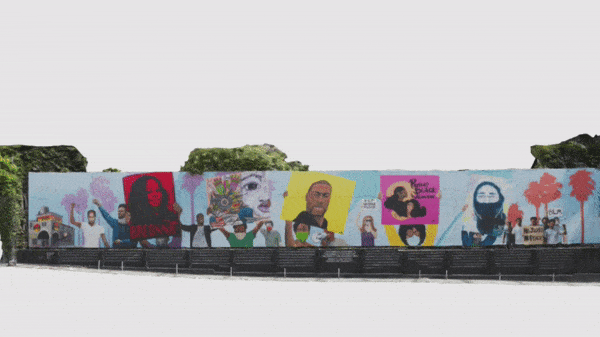Review: Breonna Taylor and the grim power of Vanity Fair’s unflinching cover portrait
- Share via
Scrubs.
That’s the word that came immediately to mind when I first saw the remarkable cover to the remarkable September issue of Vanity Fair, whose guest editor, the formidable Ta-Nehisi Coates, takes devastating aim at the systematic depredations wrought by a persistent American culture of white supremacy.
Scrubs are the spotless clothes worn by doctors, nurses and other medical professionals in the hospital, in order to protect their endangered patients. Twenty-six-year-old Breonna Taylor, the magazine’s posthumous cover subject, was an emergency room technician with plans to become a nurse, fulfilling a long-standing interest in medicine. She was shot to death in March in the hallway of her Louisville, Ky., apartment after three policemen broke in with a battering ram, unannounced, and opened fire.
Taylor was fatally struck by five bullets. One policeman has been fired, but no arrests have yet been made.
On the magazine’s cover, the young Black woman is not shown wearing scrubs. She’s dressed instead as if for a red carpet arrival — a long evening dress — in keeping with the magazine’s celebrity image. Painter Amy Sherald has saturated the life-size portrait in medium blue tones, with undercurrents of green. Scrubs come in many colors, but blue or green is a standard. (In Louisville, blue is the color of the uniform worn by an EMT.) A fatal sickness runs rampant across the land, and an emergency worker has arrived.
In Sherald’s painting, deep azure describes the solid hue of Taylor’s long, flowing dress, cinched at the waist, its full skirt stylishly slit up to the thigh. (The dress designer was Atlanta-based Jasmine Elder, although the painter added the slit.) The V-neck of its bodice frames her face, while her body, slightly turned toward a three-quarter pose, lets the V rhyme with the cut of the loose, short sleeves.
The color fans out to encompass the background too. A flat, uninterrupted expanse, like a clear blue sky, constructs a celestial atmosphere. The composition couldn’t be more different from the pleasant if pedestrian illustration of Taylor by Alexis Franklin that bumped Oprah Winfrey from the cover of O for the first time in that magazine’s 20-year history.
Sherald, a Baltimore-based artist, is best known for her official portrait of Michelle Obama now in the National Portrait Gallery. The dress is important in that painting, too, its geometric patterns splashed on a white background suggesting both the famous quilt designs produced by generations of African American women in the Alabama hamlet of Gee’s Bend and the radical 1920s textiles of pioneering German Bauhaus artist Anni Albers.
The first lady, like Taylor, is also seated against a clear blue ground. The mountainous volume of her white dress makes her virtually an Olympian figure.
In the magazine, the painter tells men’s fashion editor Miles Pope that she added details specific to Taylor’s life to her portrait, which necessarily relied on photographs of a woman she could not meet. A small gold cross hangs from a slender gold chain around her neck. The discreet engagement ring on her left hand signals for posterity the once planned, now never-to-be-delivered marriage proposal from Kenneth Walker, who was with her the night she was slain.
Taylor’s visual address to a viewer is direct and unflinching — right hand on hip, gaze serious, eyes firmly fixed. She looks at you, looking at her. Her rich, brown skin has been grayed, the painter’s trademark device for excluding the idea of color as race.
The result is powerful — Breonna Taylor rendered as a Nike, a fierce icon of victory. Has Vanity Fair ever before published a posthumous cover subject? In our conflicted moment of social unrest, the characterization is fully fitting for a magazine whose cover is otherwise best known as a commercially minded celebrity marketing tool.
Is the cover merely performative? A virtue signal, unashamedly flagged for commercial gain rather than a genuine expression of shifting social consciousness?
Perhaps it is both. Vanity Fair, after all, is an imprint that had been dead for nearly 50 years when suddenly it was revived with the glitzy 1981 launch of the Reagan administration. The fit was seamless. That cruel era of aristocratic conservatism has had generational consequences, which only now are in the throes of unraveling on the nation’s streets.
Artists as a class are regularly ignored in American life, unless a high net worth serves as a functional framing device. But the Coates-edited issue of the magazine engages compelling work by several notable Black artists, including LaToya Ruby Frazier, Deana Lawson and Hank Willis Thomas.
What Sherald’s life-size Taylor painting might look like when eventually encountered in person, rather than on the front of the publication for which it was designed, remains to be seen. Louisville’s Speed Art Museum, which has shown Sherald’s work in the past, has approached the artist about exhibiting the portrait in Taylor’s hometown.
But for Eric Garner, Walter Scott, Botham Jean, Elijah McClain, Michael Brown, Trayvon Martin, Amadou Diallo, Heather Heyer, George Floyd, Corey Jones, Laquan McDonald, the Cheyenne and Arapaho, Malice Green and Eleanor Bumpurs — the partial catalog of people murdered in the dark shadow of systemic white racism named in Coates’ searing introductory essay — it seems a grim but suitable cover. In this time of mass death, the visual invocation of scrubs, accidental or not, is one reason why. The emergency is real.
The Black Lives Matter movement has inspired murals honoring Black lives and people killed by police brutality. But time poses a threat to the art.
More to Read
The biggest entertainment stories
Get our big stories about Hollywood, film, television, music, arts, culture and more right in your inbox as soon as they publish.
You may occasionally receive promotional content from the Los Angeles Times.












